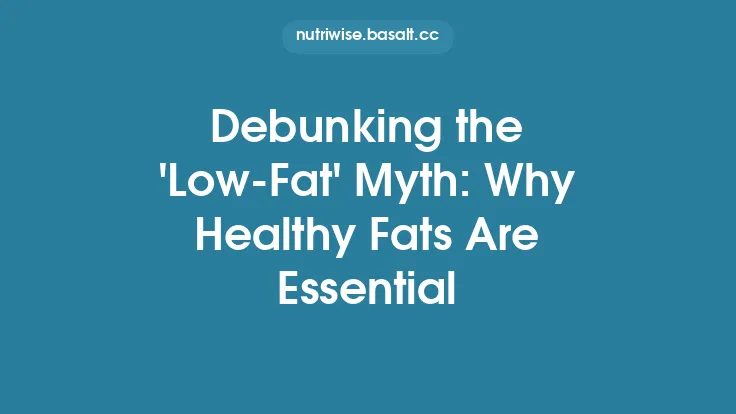When we think about weight management, the mantra “a calorie is a calorie” often feels like gospel. It’s simple, easy to understand, and seems to put the power of weight control squarely in our hands: eat less, move more, and the scale will follow. Yet anyone who has tried to lose weight—or simply maintain a healthy body composition—quickly discovers that the reality is far messier. While the first law of thermodynamics (energy in = energy out) still holds true, the way our bodies process, store, and respond to calories is influenced by a host of factors that make some calories more “costly” or “beneficial” than others. Below we unpack the most common myths surrounding calorie counting and explain why not all calories are created equal.
The Thermic Effect of Food (TEF): Not All Calories Are Metabolized the Same Way
The thermic effect of food refers to the energy expended by the body to digest, absorb, and metabolize nutrients. Roughly 5‑10 % of the calories we consume are burned during this process, but the exact percentage varies dramatically by macronutrient:
| Nutrient | Approximate TEF |
|---|---|
| Protein | 20‑30 % |
| Carbohydrate | 5‑10 % |
| Fat | 0‑3 % |
Because protein has the highest TEF, a 100‑calorie serving of lean meat may result in only ~70‑80 net calories after digestion, whereas 100 calories from pure fat may be almost fully retained. This means that two meals with identical caloric totals can have different net energy impacts on the body.
Hormonal Responses: Insulin, Leptin, and the Satiety Cascade
When we eat, our endocrine system releases hormones that dictate how we store or burn energy. Insulin, released in response to carbohydrate intake, promotes glucose uptake and fat storage. Leptin, secreted by adipose tissue, signals satiety to the brain, while ghrelin stimulates hunger.
- High‑glycemic foods (e.g., refined sugars, white bread) cause rapid spikes in blood glucose and insulin, which can lead to a subsequent drop in blood sugar and a rebound increase in hunger. This can cause people to consume more calories overall, even if the initial portion was modest.
- Protein‑rich foods stimulate the release of peptide YY (PYY) and glucagon‑like peptide‑1 (GLP‑1), both of which enhance satiety and reduce subsequent calorie intake.
Thus, the hormonal milieu triggered by different foods can influence how many additional calories we end up eating later in the day, making the “calorie‑for‑calorie” comparison incomplete.
Food Matrix and Nutrient Density: The Role of Micronutrients and Fiber
The food matrix describes the physical and chemical structure of a food, including how nutrients are bound together. Whole foods—such as fruits, vegetables, legumes, and nuts—contain fiber, water, vitamins, minerals, and phytochemicals that affect digestion and absorption.
- Fiber adds bulk without adding calories, slows gastric emptying, and blunts post‑prandial glucose spikes. A 200‑calorie serving of a high‑fiber salad will likely leave you feeling fuller longer than a 200‑calorie serving of processed snack foods.
- Micronutrients (vitamins and minerals) are essential for metabolic pathways that convert food into usable energy. Deficiencies can impair mitochondrial function, reducing the efficiency of calorie utilization.
Because the matrix of whole foods can modulate satiety, digestion speed, and metabolic efficiency, two foods with the same caloric content can have vastly different effects on body weight and health.
Gut Microbiota: The Hidden Calorie Modulators
Our intestines host trillions of microbes that help break down otherwise indigestible components of food, especially complex carbohydrates and fiber. The composition of the gut microbiome can influence:
- Energy extraction – Certain bacterial strains are more efficient at fermenting fiber into short‑chain fatty acids (SCFAs) that the body can absorb as calories.
- Hormonal signaling – SCFAs interact with receptors that affect appetite regulation and insulin sensitivity.
- Inflammation – Dysbiosis (an imbalanced microbiome) can promote low‑grade inflammation, which is linked to insulin resistance and altered energy storage.
Consequently, two individuals eating identical meals may experience different net caloric gains depending on their microbial profile.
Metabolic Adaptation: The Body’s Defense Against Caloric Deficits
When caloric intake is reduced dramatically, the body initiates adaptive thermogenesis—a reduction in resting metabolic rate (RMR) to conserve energy. This phenomenon explains why many people hit a “plateau” after an initial period of weight loss.
- Loss of lean mass: Calorie restriction often leads to loss of muscle tissue, which is metabolically active. Fewer muscle cells mean fewer calories burned at rest.
- Hormonal shifts: Decreased leptin and thyroid hormone levels signal the body to become more energy‑efficient.
Because metabolic adaptation is more pronounced when the diet is low in protein and micronutrients, a calorie‑restricted diet composed mainly of processed foods can trigger a larger slowdown than a similarly calorie‑restricted diet rich in whole foods.
Energy Density vs. Caloric Density
Energy density refers to the number of calories per gram of food. Foods with low energy density (e.g., broth‑based soups, leafy greens) allow larger portion sizes with fewer calories, promoting satiety without excess intake. Conversely, high‑energy‑density foods (e.g., nuts, oils, cheese) pack many calories into a small volume.
While the total calories still matter, the perception of fullness and the ease of overeating are heavily influenced by energy density. This is why diets emphasizing low‑energy‑density foods often succeed in weight management despite not requiring strict calorie counting.
Practical Takeaways for a More Nuanced Approach to Calories
- Prioritize protein – Aim for 1.2‑1.6 g per kilogram of body weight daily. Higher protein intake raises TEF, preserves lean mass, and enhances satiety.
- Choose whole, minimally processed foods – Their fiber, water, and nutrient content lower energy density and improve hormonal responses.
- Mind the glycemic impact – Pair carbohydrates with protein, fat, or fiber to blunt insulin spikes and reduce subsequent hunger.
- Support a healthy gut – Include prebiotic fibers (e.g., inulin, resistant starch) and probiotic foods (e.g., fermented vegetables) to foster a balanced microbiome.
- Track quality, not just quantity – If you must count calories, use a food diary that also records macronutrient distribution and fiber intake.
- Watch for metabolic adaptation – Incorporate resistance training to preserve muscle mass and keep RMR elevated during calorie deficits.
- Listen to internal cues – Satiety signals, hunger levels, and energy fluctuations can guide portion sizes more effectively than a rigid calorie target.
Bottom Line: Calories Are a Starting Point, Not the Whole Story
The statement “a calorie is a calorie” captures a fundamental truth about energy balance, but it glosses over the complex biological, chemical, and behavioral factors that determine how those calories are processed. Protein’s higher thermic effect, the hormonal cascades triggered by different macronutrients, the influence of the food matrix, gut microbiota, and adaptive metabolic responses all mean that the quality and context of calories matter just as much—if not more—than the raw number on the label.
By moving beyond simple calorie counting and embracing a more holistic view of nutrition—one that values nutrient density, satiety, and metabolic health—we can create sustainable eating patterns that support weight management, energy levels, and long‑term well‑being.





